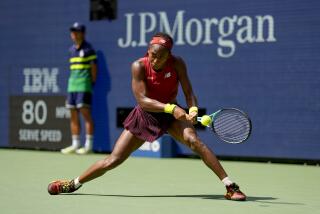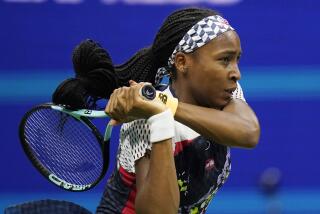Kohde-Kilsch Finds She Can Do Nothing Against Dominant Graf
- Share via
SAN DIEGO — The shock was not that top-ranked Steffi Graf won another match, 6-0, 6-0. The shock was who she did it against.
This was not a first-round sacrifice, an opponent drawn at random. This time the loser was Claudia Kohde-Kilsch, once ranked as high as fourth in the world and, until Graf came along, the leading women’s tennis player in West Germany.
The victory, before 3,656 in an afternoon quarterfinal Thursday of the Great American Bank tournament at the San Diego Tennis and Racquet Club, was quick and overwhelming.
Kohde-Kilsch could not hide her disbelief. Never in her 10-year career, she said, had she been held without a game.
“It’s not embarrassing,” she said. “People who saw the match know how unbelievably she played. It’s just hard for myself. It is not possible.
“I had a good feeling about the match. I had two good matches (in the tournament). I had practiced very well. It’s not that I am off or something. I tried until the last ball. I really never thought I would lose 6-love, 6-love. But she played without any mistakes and so powerful.”
Gretchen Magers of San Diego had a tougher time with 15-year-old Angelica Gavaldon of Coronado in front of 2,756 in the final match of the day, winning, 6-2, 7-5, in the round of 16.
Magers led, 5-2, in the second set. But Gavaldon, who will be a junior at Our Lady of Peace, won the next three games--including two services breaks--to make it 5-5. She double-faulted away the next game, however, and Magers held service for the victory.
Graf had no such trouble with seventh-seeded Kohde-Kilsch, whose ranking dropped to No. 30 after she took 2 1/2 months off this spring for a rest. Even Graf was taken aback by the ease of her victory.
“She is a very good serve-and-volley player and also is someone who can play from the back,” Graf said. “She has been in the top 10 for a long time. She always has had a very good ranking. I expected a much more difficult match.”
It lasted 42 minutes. Graf allowed Kohde-Kilsch just 22 points, eight in a first set that took 17 minutes.
In winning three matches to advance to the semifinal Saturday against the winner of today’s quarterfinal between Ann Grossman and Bettina Bunge, Graf has lost two games (to Betsy Nagelsen in the second round) and her matches have averaged 42 minutes.
“Was it fast again?” Graf said after being told of the match time Thursday. “Oh, no.”
It was Graf’s 10th match victory in a row over Kohde-Kilsch. She lost their first two meetings in 1984 when Graf was 14-year-old, second-year professional, and Kohde-Kilsch was 20-year-old ranked in the top 10.
The last time they played, in the quarterfinals of the Australian Open in January, Graf surrendered five games in a 6-2, 6-3 victory.
“I had more chances to come in and do something that time,” Kohde-Kilsch said. “I got her to miss a few forehands. (This time) she was just so confident. She didn’t miss anything.
“I don’t know what else I could have done. Maybe hit two or three more volleys, but she is so quick. I was hitting my balls well. I was moving well. Maybe I could have served better. But there was nothing much else I could do.”
The feeling of helplessness is something many Graf opponents sense. Graf’s first-round opponent, Rene Simpson of Toronto, said after her 6-0, 6-0 loss Monday that she entered the match never believing she could win. But Simpson is ranked 80th in the world; Kohde-Kilsch has won $1.9 million as a pro.
“You can see she was nervous,” Graf said. “I know she can play much better. She is making double faults, sometimes at inappropriate points. You don’t want to win, 6-0, 6-0, against someone you know so well. It is difficult to know how to react afterward.”
Imagine how Kohde-Kilsch felt.
“If you think about it yourself, you don’t know what you did wrong and what you did right,” Kohde-Kilsch said. “But my family is here, and they told me, ‘You couldn’t do more. She played unbelievable. You are still a good player. If she plays this great, just forget about it. Think of the next match.’ ”
The tournament is Graf’s first since her Wimbledon victory July 9. It is part of her hard-court warmup for the U.S. Open at the end of the month. She is skipping the Virginia Slims of Los Angeles next week and will play in Mahwah, N.J., the following week. But her first three matches in San Diego have given her little chance to test her skills.
“You enjoy it more if it is a tougher match, if you are pushed a little bit,” Graf said. “The last couple of weeks I have become stronger in the way I am playing. I am going into the ball. I have had chances to go into the net, and I know I can win the points from there. I have more strength in my game.”
That can come as little comfort around the circuit. Graf has lost only twice in 57 matches this year--to Gabriela Sabatini in March in the finals at Amelia Island. Fla., and to Arantxa Sanchez of Spain in the French Open final in June.
In other singles matches, sixth-seeded Nathalie Tauziat of France defeated Gigi Fernandez of Miami, 6-3, 1-6, 6-1, and Bunge of West Germany defeated Jo Durie of Great Britain, 6-1, 6-1.
More to Read
Go beyond the scoreboard
Get the latest on L.A.'s teams in the daily Sports Report newsletter.
You may occasionally receive promotional content from the Los Angeles Times.










